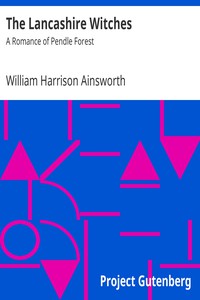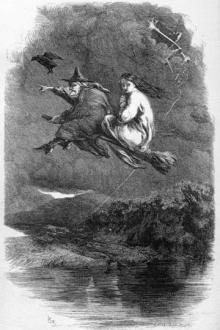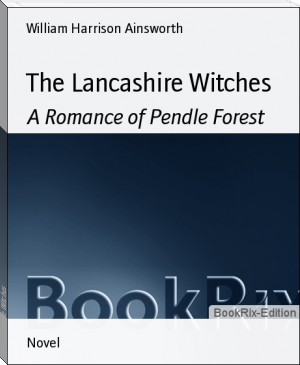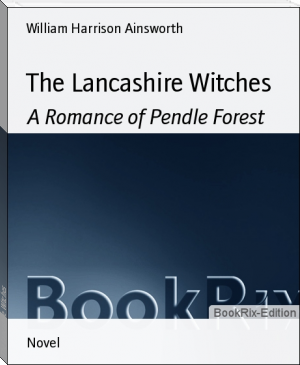The Lancashire Witches: A Romance of Pendle Forest by William Harrison Ainsworth (old books to read .txt) 📖

- Author: William Harrison Ainsworth
Book online «The Lancashire Witches: A Romance of Pendle Forest by William Harrison Ainsworth (old books to read .txt) 📖». Author William Harrison Ainsworth
With this, he peered about among the crowd in search of the magistrate, but though he thrust his little turned-up nose in every direction, he could not find him, and therefore set out for the Abbey, concluding he had gone thither.
As Mistress Nutter walked along, she perceived James Device among the crowd, holding Jennet by the hand, and motioned him to come to her. Jem instantly understood the sign, and quitting his little sister, drew near.
"Tell thy mother," said Mistress Nutter, in a tone calculated only for his hearing, "to come to me, at the Abbey, quickly and secretly. I shall be in the ruins of the old convent church. I have somewhat to say to her, that concerns herself as well as me. Thou wilt have to go to Rough Lee and Malkin Tower to-night."
Jem nodded, to show his perfect apprehension of what was said and his assent to it, and while Mistress Nutter moved on with a slow and dignified step, he returned to Jennet, and told her she must go home directly, a piece of intelligence which was not received very graciously by the little maiden; but nothing heeding her unwillingness, Jem walked her off quickly in the direction of the cottage; but while on the way to it, they accidentally encountered their mother, Elizabeth Device, and therefore stopped.
"Yo mun go up to th' Abbey directly, mother," said Jem, with a wink, "Mistress Nutter wishes to see ye. Yo'n find her i' t' ruins o' t' owd convent church. Tak kere yo're neaw seen. Yo onderstond."
"Yeigh," replied Elizabeth, nodding her head significantly, "ey'n go at wonst, an see efter Alizon ot t' same time. Fo ey'm towd hoo has fainted, an been ta'en to th' Abbey by Lady Assheton."
"Never heed Alizon," replied Jem, gruffly. "Hoo's i' good hands. Ye munna be seen, ey tell ye. Ey'm going to Malkin Tower to-neet, if yo'n owt to send."
"To-neet, Jem," echoed little Jennet.
"Eigh," rejoined Jem, sharply. "Howd te tongue, wench. Dunna lose time, mother."
And as he and his little sister pursued their way to the cottage, Elizabeth hobbled off towards the Abbey, muttering, as she went, "I hope Alizon an Mistress Nutter winna meet. Nah that it matters, boh still it's better not. Strange, the wench should ha' fainted. Boh she's always foolish an timmersome, an ey half fear has lost her heart to young Richard Assheton. Ey'n watch her narrowly, an if it turn out to be so, she mun be cured, or be secured—ha! ha!"
And muttering in this way, she passed through the Abbey gateway, the wicket being left open, and proceeded towards the ruinous convent church, taking care as much as possible to avoid observation.
CHAPTER V.—MOTHER CHATTOX.Not far from the green where the May-day revels were held, stood the ancient parish church of Whalley, its square tower surmounted with a flag-staff and banner, and shaking with the joyous peals of the ringers. A picturesque and beautiful structure it was, though full of architectural incongruities; and its grey walls and hoary buttresses, with the lancet-shaped windows of the choir, and the ramified tracery of the fine eastern window, could not fail to please any taste not quite so critical as to require absolute harmony and perfection in a building. Parts of the venerable fabric were older than the Abbey itself, dating back as far as the eleventh century, when a chapel occupied the site; and though many alterations had been made in the subsequent structure at various times, and many beauties destroyed, especially during the period of the Reformation, enough of its pristine character remained to render it a very good specimen of an old country church. Internally, the cylindrical columns of the north aisle, the construction of the choir, and the three stone seats supported on rounded columns near the altar, proclaimed its high antiquity. Within the choir were preserved the eighteen richly-carved stalls once occupying a similar position in the desecrated conventual church: and though exquisite in themselves, they seemed here sadly out of place, not being proportionate to the structure. Their elaborately-carved seats projected far into the body of the church, and their crocketed pinnacles shot up almost to the ceiling. But it was well they had not shared the destruction in which almost all the other ornaments of the magnificent fane they once decorated were involved. Carefully preserved, the black varnished oak well displayed the quaint and grotesque designs with which many of them—the Prior's stall in especial—were embellished. Chief among them was the abbot's stall, festooned with sculptured vine wreaths and clustering grapes, and bearing the auspicious inscription:
Semper gaudentes sint ista sede sedentes:
singularly inapplicable, however, to the last prelate who filled it. Some fine old monuments, and warlike trophies of neighbouring wealthy families, adorned the walls, and within the nave was a magnificent pew, with a canopy and pillars of elaborately-carved oak, and lattice-work at the sides, allotted to the manor of Read, and recently erected by Roger Nowell; while in the north and south aisles were two small chapels, converted since the reformed faith had obtained, into pews—the one called Saint Mary's Cage, belonging to the Assheton family; and the other appertaining to the Catterals of Little Mitton, and designated Saint Nicholas's Cage. Under the last-named chapel were interred some of the Paslews of Wiswall, and here lay the last unfortunate Abbot of Whalley, between whoso grave, and the Assheton and Braddyll families, a fatal relation was supposed to subsist. Another large pew, allotted to the Towneleys, and designated Saint Anthony's Cage, was rendered remarkable, by a characteristic speech of Sir John Towneley, which gave much offence to the neighbouring dames. Called upon to decide as to the position of the sittings in the church, the discourteous knight made choice of Saint Anthony's Cage, already mentioned, declaring, "My man, Shuttleworth of Hacking, made this form, and here will I sit when I come; and my cousin Nowell may make a seat behind me if he please, and my son Sherburne shall make one on the other side, and Master Catteral another behind him, and for the residue the use shall be, first come first speed, and that will make the proud wives of Whalley rise betimes to come to church." One can fancy the rough knight's chuckle, as he addressed these words to the old clerk, certain of their being quickly repeated to the "proud wives" in question.
Within the churchyard grew two fine old yew-trees, now long since decayed and gone, but then spreading their dark-green arms over the little turf-covered graves. Reared against the buttresses of the church was an old stone coffin, together with a fragment of a curious monumental effigy, likewise of stone; but the most striking objects in the place, and deservedly ranked amongst the wonders of Whalley, were three remarkable obelisk-shaped crosses, set in a line upon pedestals, covered with singular devices in fretwork, and all three differing in size and design. Evidently of remotest antiquity, these crosses were traditionally assigned to Paullinus, who, according to the Venerable Bede, first preached the Gospel in these parts, in the early part of the seventh century; but other legends were attached to them by the vulgar, and dim mystery brooded over them.
Vestiges of another people and another faith were likewise here discernible, for where the Saxon forefathers of the village prayed and slumbered in death, the Roman invaders of the isle had trodden, and perchance performed their religious rites; some traces of an encampment being found in the churchyard by the historian of the spot, while the north boundary of the hallowed precincts was formed by a deep foss, once encompassing the nigh-obliterated fortification. Besides these records of an elder people, there was another memento of bygone days and creeds, in a little hermitage and chapel adjoining it, founded in the reign of Edward III., by Henry, Duke of Lancaster, for the support of two recluses and a priest to say masses daily for him and his descendants; but this pious bequest being grievously abused in the subsequent reign of Henry VI., by Isole de Heton, a fair widow, who in the first transports of grief, vowing herself to heaven, took up her abode in the hermitage, and led a very disorderly life therein, to the great scandal of the Abbey, and the great prejudice of the morals of its brethren, and at last, tired even of the slight restraint imposed upon her, fled away "contrary to her oath and profession, not willing, nor intending to be restored again;" the hermitage was dissolved by the pious monarch, and masses ordered to be said daily in the parish church for the repose of the soul of the founder. Such was the legend attached to the little cell, and tradition went on to say that the anchoress broke her leg in crossing Whalley Nab, and limped ever afterwards; a just judgment on such a heinous offender. Both these little structures were picturesque objects, being overgrown with ivy and woodbine. The chapel was completely in ruins, while the cell, profaned by the misdoings of the dissolute votaress Isole, had been converted into a cage for vagrants and offenders, and made secure by a grated window, and a strong door studded with broad-headed nails.
The view from the churchyard, embracing the vicarage-house, a comfortable residence, surrounded by a large walled-in garden, well stocked with fruit-trees, and sheltered by a fine grove of rook-haunted timber, extended on the one hand over the village, and on the other over the Abbey, and was bounded by the towering and well-wooded heights of Whalley Nab. On the side of the Abbey, the most conspicuous objects were the great north-eastern gateway, with the ruined conventual church. Ever beautiful, the view was especially so on the present occasion, from the animated scene combined with it; and the pleasant prospect was enjoyed by a large assemblage, who had adjourned thither to witness the concluding part of the festival.
Within the green and flower-decked bowers which, as has before been mentioned, were erected in the churchyard, were seated Doctor Ormerod and Sir Ralph Assheton, with such of their respective guests as had not already retired, including Richard and Nicholas Assheton, both of whom had returned from the abbey; the former having been dismissed by Lady Assheton from further attendance upon Alizon, and the latter having concluded his discourse with Parson Dewhurst, who, indeed, accompanied him to the church, and was now placed between the Vicar and the Rector of Middleton. From this gentle elevation the gay company on the green could be fully discerned, the tall May-pole, with its garlands and ribands, forming a pivot, about which the throng ever revolved, while stationary amidst the moving masses, the rush-cart reared on high its broad green back, as if to resist the living waves constantly dashed against it. By-and-by a new kind of movement was perceptible, and it soon became evident that a procession was being formed. Immediately afterwards, the rush-cart was put in motion, and winded slowly along the narrow street leading to the church, preceded by the morris-dancers and the other May-day revellers, and followed by a great concourse of people, shouting, dancing, and singing.
On came the crowd. The jingling of bells, and the sound of music grew louder and louder, and the procession, lost for awhile behind some intervening habitations, though the men bestriding the rush-cart could be discerned over their summits, burst suddenly into view; and the revellers entering the churchyard, drew up on either side of the little path leading to the porch, while the rush-cart coming up the next moment, stopped at the gate. Then four young maidens dressed in white, and having baskets in their hands, advanced and scattered flowers along the path; after which ladders were reared against the sides of the rush-cart, and the men, descending from their exalted position, bore the garlands to the church, preceded by the vicar and the two other divines, and followed by Robin Hood and his band, the morris-dancers, and a troop of little children singing a hymn. The next step was to unfasten the bundles of rushes, of which the cart was composed, and this was very quickly and skilfully performed, the utmost care being taken of the trinkets and valuables with which it was ornamented. These were gathered together in baskets and conveyed to the vestry, and there locked up. This done, the bundles of rushes were taken up by several old women, who strewed the aisles with them, and placed such as had been tied up as mats in the pews. At the same time, two casks of ale set near the gate, and given for the occasion by the vicar, were broached, and their foaming contents freely distributed among the dancers and the thirsty crowd. Very merry were they, as may be supposed, in consequence, but their mirth was happily kept within due limits of decorum.
When the rush-cart was wellnigh unladen Richard Assheton entered the church, and greatly pleased with the effect
 Have you ever thought about what fiction is? Probably, such a question may seem surprising: and so everything is clear. Every person throughout his life has to repeatedly create the works he needs for specific purposes - statements, autobiographies, dictations - using not gypsum or clay, not musical notes, not paints, but just a word. At the same time, almost every person will be very surprised if he is told that he thereby created a work of fiction, which is very different from visual art, music and sculpture making. However, everyone understands that a student's essay or dictation is fundamentally different from novels, short stories, news that are created by professional writers. In the works of professionals there is the most important difference - excogitation. But, oddly enough, in a school literature course, you don’t realize the full power of fiction. So using our website in your free time discover fiction for yourself.
Have you ever thought about what fiction is? Probably, such a question may seem surprising: and so everything is clear. Every person throughout his life has to repeatedly create the works he needs for specific purposes - statements, autobiographies, dictations - using not gypsum or clay, not musical notes, not paints, but just a word. At the same time, almost every person will be very surprised if he is told that he thereby created a work of fiction, which is very different from visual art, music and sculpture making. However, everyone understands that a student's essay or dictation is fundamentally different from novels, short stories, news that are created by professional writers. In the works of professionals there is the most important difference - excogitation. But, oddly enough, in a school literature course, you don’t realize the full power of fiction. So using our website in your free time discover fiction for yourself. 




Comments (0)